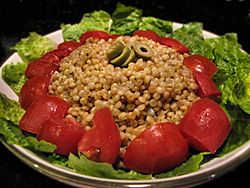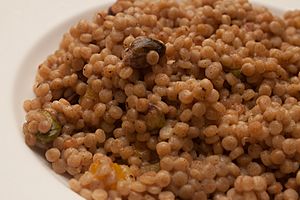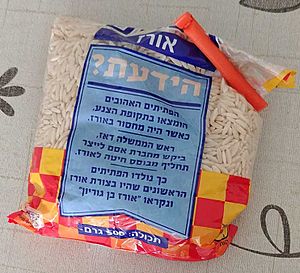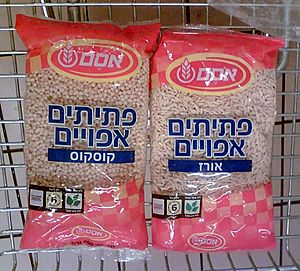Israeli couscous facts for kids
 |
|||||||
| Alternative names | Ptitim or P'titim | ||||||
|---|---|---|---|---|---|---|---|
| Type | Pasta | ||||||
| Course | Side dish | ||||||
| Place of origin | Israel | ||||||
| Created by | Osem | ||||||
| Main ingredients | Wheat | ||||||
| 200 kcal (837 kJ) | |||||||
|
|||||||
Israeli couscous (also known as Ptitim) is a type of small, toasted pasta. It's shaped like tiny balls. This food was created in Israel during the 1950s. At that time, it was hard to find rice because of a period called "austerity." Even though it's called "couscous" in English, it's actually a different kind of pasta.
The Story of Ptitim
Ptitim was invented in 1953. This was during a time in Israel when resources were scarce. Israel's first prime minister, David Ben-Gurion, had an idea. He asked Eugen Proper, one of the people who started the Osem food company, to create a new food. He wanted a wheat-based food that could be used instead of rice.
The Osem company accepted the challenge. They developed ptitim, which is made from hard wheat flour. It is then toasted in an oven. At first, ptitim was made to look like grains of rice. It became very popular. After its success, Osem also started making a ball-shaped version. This new shape was inspired by couscous. Because of its origin, ptitim is sometimes called "Ben-Gurion rice."
How Ptitim is Made and Eaten
Ptitim is made by pushing dough through a round mold. Then, it is cut and toasted. This process gives it a uniform shape and a special nutty flavor. Unlike most types of pasta and couscous, ptitim has always been made in factories. It's not usually made from scratch at home. The ptitim you buy in stores is easy and quick to cook.
In Israel, ptitim is a favorite food among children. They often eat it plain. Sometimes, they mix it with fried onion and tomato paste. Today, ptitim is made in fun shapes like rings, stars, and hearts. You can also find versions made with whole wheat and spelt flour. These are for people who want healthier options. Ptitim has also become popular in other countries. In the United States, you can find it in fancy food stores. It is also on the menus of modern American chefs.

Ptitim can be used in many different kinds of dishes. It works well in both hot and cold meals. The small grains keep their shape and texture even when they are reheated. They also don't stick together. Often, ptitim is cooked with sautéed onions or garlic. You can also add vegetables, meat, chicken, or sausage. The ptitim grains can be fried for a short time before adding water. They can also be baked, put into soup, or served in a pie. Some people use it for stuffing or make it like a risotto. Ptitim can also replace pasta or rice in other recipes. An American chef named Charlie Trotter even created recipes for ptitim-based gourmet dishes, including desserts!
Other Foods Like Ptitim
Ptitim looks very similar to a food called farfel. Farfel was brought to Israel by Ashkenazi Jews from Europe a long time ago. People often use farfel instead of ptitim, and vice versa.
Ptitim's round shape reminds some people of "pearl" couscous from the Middle East. These older types of couscous are known as moghrabieh in Jordan, Lebanon, and Syria. They are called maftoul in Palestinian cuisine. However, these Middle Eastern dishes are made by coating couscous. Ptitim, on the other hand, is made by pushing dough through a machine. Because of this, they taste and are prepared very differently.
Ptitim also looks like berkoukes from North Africa and fregula from Sardinia. But these foods are also rolled and coated, not extruded like ptitim. Ptitim also resembles some small pastina shapes. These include acini di pepe, orzo, and stellini. However, ptitim grains are toasted before they are packaged. This gives them their chewy texture and nutty flavor, which is different from pastina.



